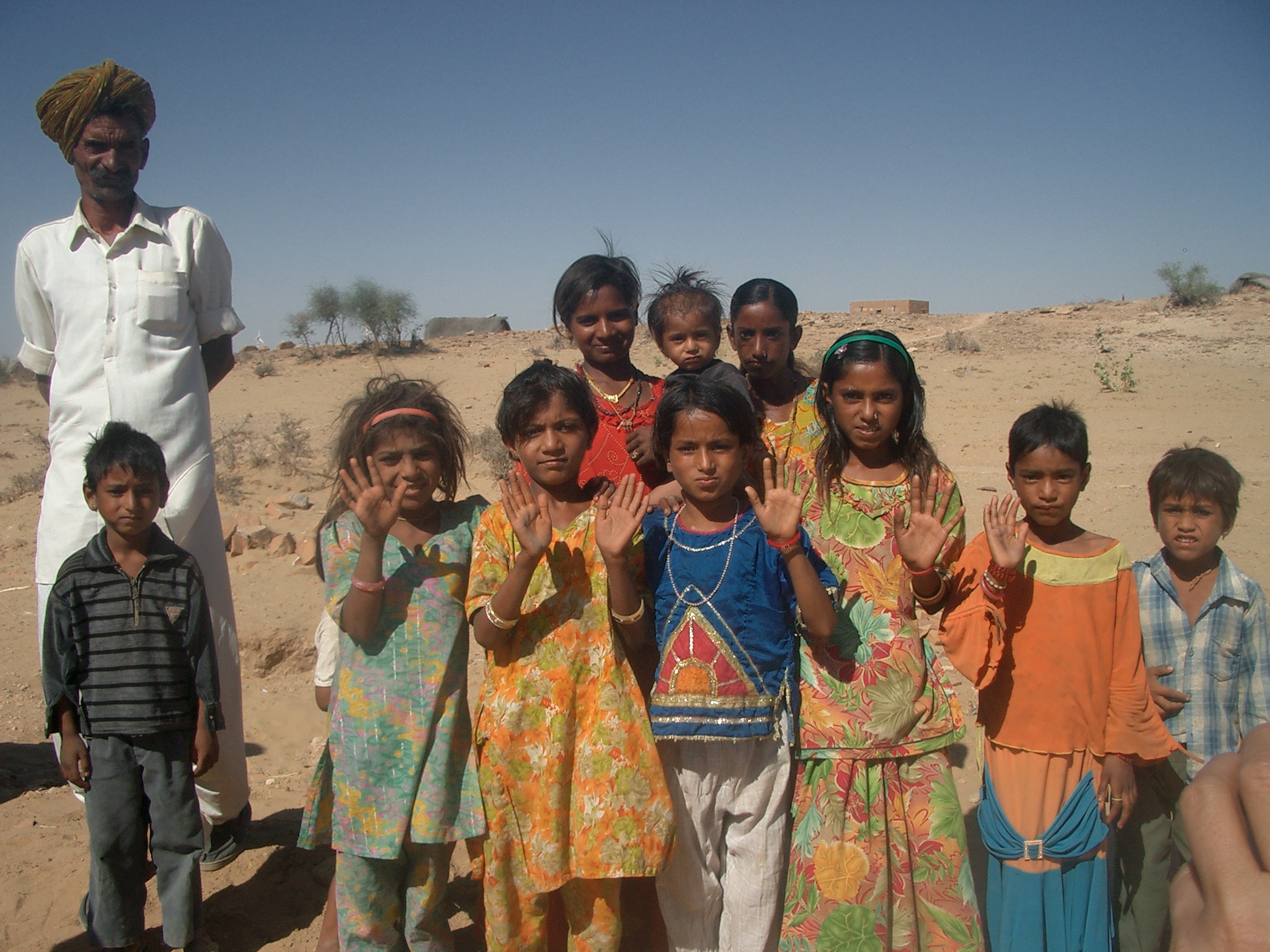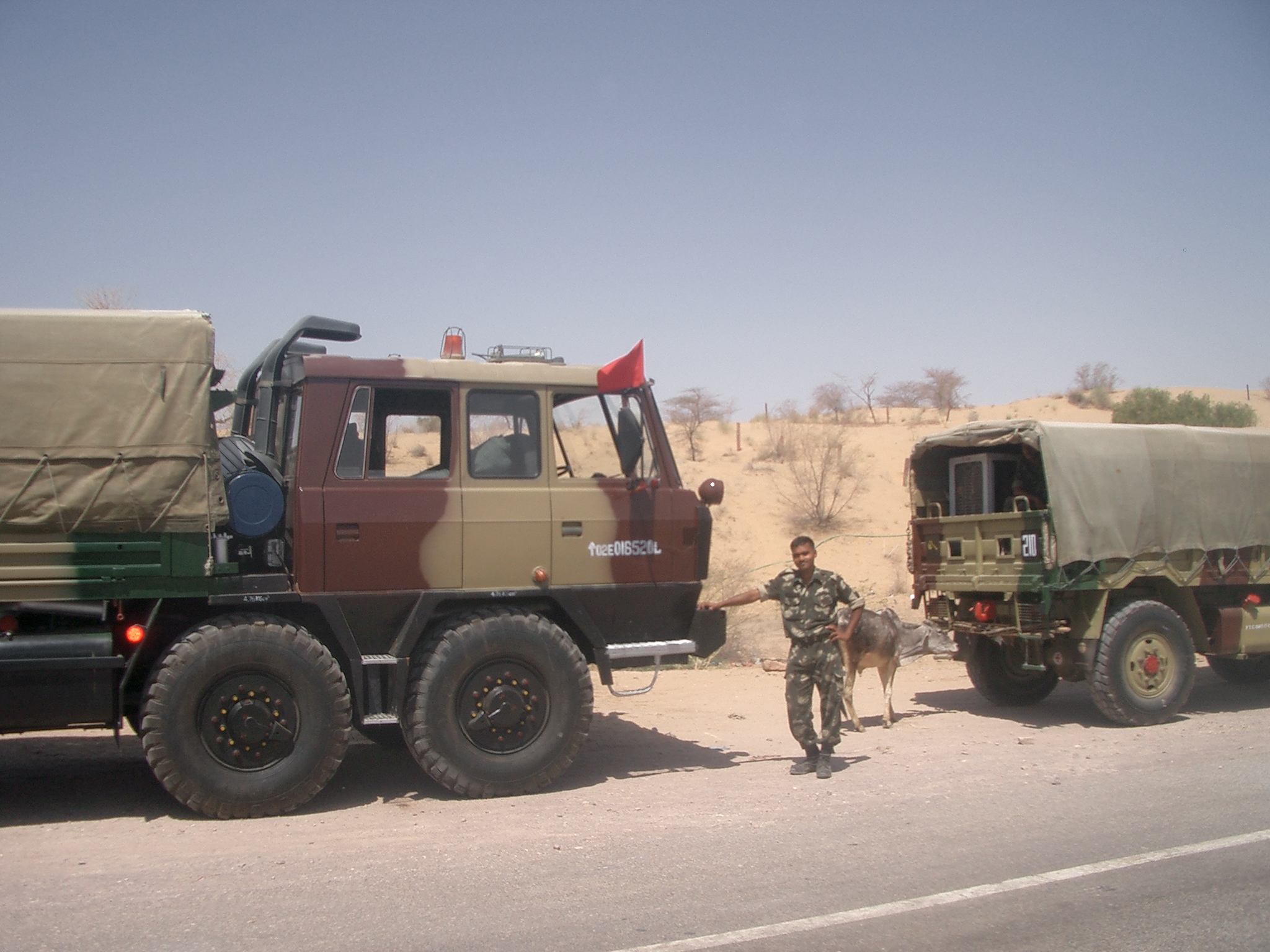
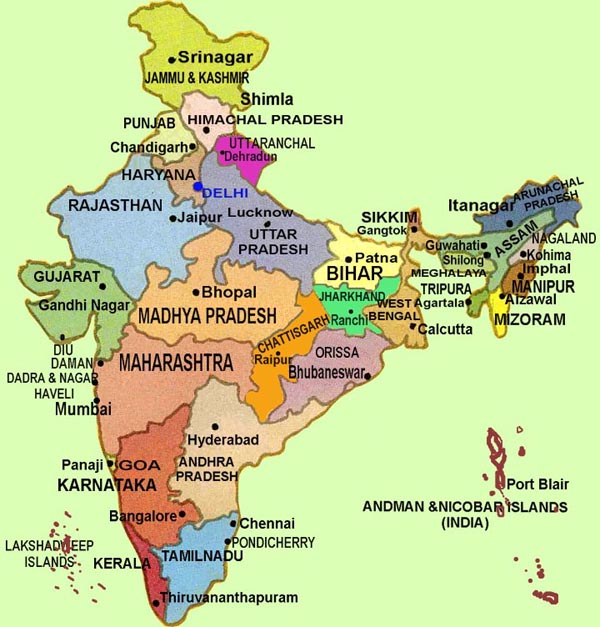
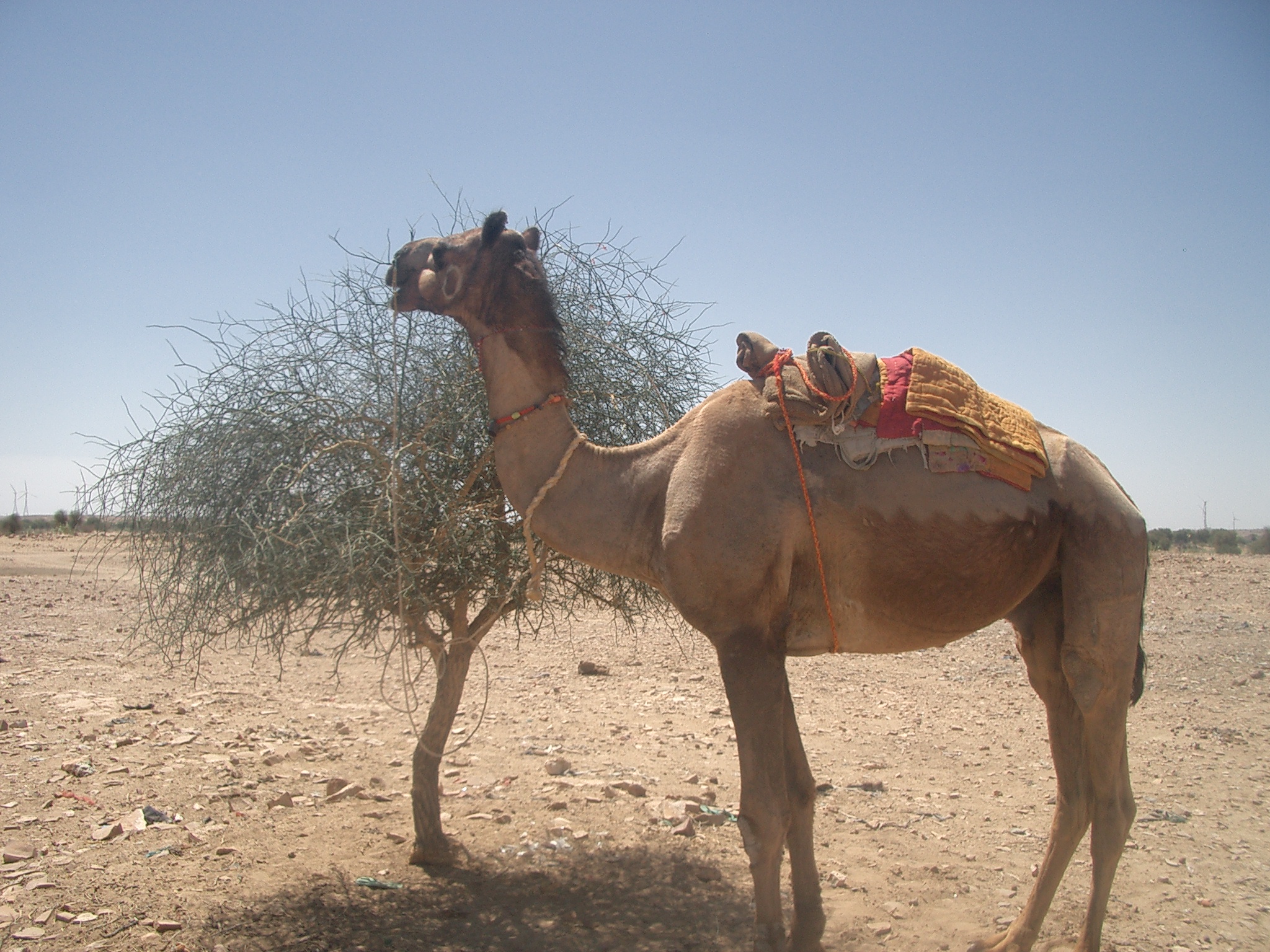
1. Abstract
Desertification in Rajasthan has led to the migration of people to other regions that are more economically sustainable. For instance, Mumbai, which is in the Western coastal region of India, has an ever increasing population due to migration of rural villagers to this metropolis. The increased population will lead to larger pressures on the environment and increased economic competition. These pressures would make religious tensions flare and a conflict could become worse. The conflict between Hindus and Muslims is centuries old and therefore it would only take a little economic tension, such as lack of land or water resources due to Climate Change.
This conflict would occur in the future because in a recent study there was a shift in the migration patterns in India. “…[a] study of tribal migration from Orissa shows that migration has changed from the rural–rural migration of the pre-1980s to rural destinations in Bihar and West Bengal, to rural–urban migration to far away metropolises such as Delhi, Kolkata and Mumbai.” (Deshingkar , 6) This shift of migration patterns is fairly recent and with a rapidly increasing population and diminishing resources, it seems as though Mumbai might be a place in which conflict could arise. Whether religious interests are pursued in this conflict are yet to be seen, but with past tensions between Hindus and Muslims it would be the natural igniter of conflict between civilians.
2. Description
Brief History of Conflict
In 1992, Hindus destroyed a 464-year-old mosque in Ajodhya; these nationalists claimed it was the holy site of the birth of their god Ram. They were able to justify to themselves the destruction of this mosque because they felt it was a desecration of their religion to have a mosque on this holy land. This set off a wave of bombings and riots. A day after the destruction of the mosque, at least 200 people were killed. As the days went on the death toll increased and the violence was all in the name of religious beliefs. The violence was some of worst since the bloodshed following Indian independence. Muslim Extremists retaliated in 1993 with the Mumbai bombings. Mumbai experienced some of the worst violence. An example of the level of violence is 59 people were killed when police opened fire on rampaging mobs. (New York Times) It seems the 1992 attack was fueled by the tensions felt by Hindus toward Muslims’ previous take over of Hindu lands.
The Gujarat riots in 2002 were retaliation to the Godhra Train Burning. The train burning killed 58 Hindu pilgrims, mostly women and children, returning from Babri Mosque. This mosque was a controversial because it was a pilgrimage site for both Hindus and Musims. Islamic extremists were angry with these Hindu pilgrims for entering into their holy space. These people were burnt alive at the Godhra railway station. This angered Hindu Nationalists and this lead to the Gujarat riots. During these riots, Hindu men killed approximately 1,000 Muslims, while Hindu women went in gangs to loot Muslim stores. Here is an account from a Muslim who unfortunately survived these attacks, “My mother, my father, brother, sister, plus an aunty and her family. We all lived together. On February 28, our house was burned. My hands and legs were burned. I ran to my employer who took me to the hospital.” (PBS, NewsWeekly) There are many stories during these riots where innocent people have taken the blame for Islamic Extremists’ actions.
The violence was not stopped by the government and this been a point of tension for Muslims. They felt their government did not care about their safety and Navendra Modi, the police commissioner, has been accused of the genocide of Muslims in Gujarat. At first, the police released a statement saying it was Ghanchi Muslims who started the fire and this is when the riots began. In a lack lust effort to stop the riots, the police released a statement saying they were not sure who started the fire and declared it an accident. In 2008, the declaration of this train fire being an accident was overturned by the High Court and it was said to be preplanned by an Islamic Extremist group. The editor of the Times of India, Siddharth Varadarajan, believes, “The killings that followed the train massacre were not spontaneous, they were not the result of mass anger on the part of Hindus, but it was an orchestrated, organized, calculated program which took place because of the ruling party. The BJP has state power in Gujarat and was able to use the power to essentially give a free hand to its party activists to indulge in this kind of criminal behavior.” Eight years after the riots, film footage is now coming out of the violence of these riots and looting, so the world can now be the judge of what truly occurred in Gujarat.
Mumbai had a train bombing on July 11, 2006. This attack killed 200 people and it was a Muslim attack against Hindus. This violence seems to have a perpetual cycle of retaliation between these two religions. Both sides have felt alienated at some point in history and therefore they continue the violence as a form of showing the other their dominance in the region. Another issue of why peace is an impossibility for these two religions is, “…many Indian Muslims today consider themselves Muslims first, not Indians. Many Indian Muslims say the words of an unrepresentative few are being used to tarnish an entire community.” (PBS, NewsWeekly) This seems to be the case on both sides because the extremists create the attacks and the retaliation comes from the opposite side’s religious extremists. Unfortunately, the innocent people of both religions suffer because of these extremists.
Explanation of current problem
The case focuses on migration from rural villages in Rajasthan to Mumbai. The reason these villagers move is due to the continued desertification of the area and therefore the lack of resources and employment in the area. Once the migration occurs, there will be economic competition because of the influx of population to the area. Since 2005, there has is a 2.4% increase in the rate of urbanization. In 2008, the total percentage of people living in urban areas was 29%. (CIA World Factbook) This increased population puts pressure on the environment and the resources in Mumbai. The conflict will happen when the city reaches carrying capacity. Clearly, there will be some migration out of the city to create sub-cities around Mumbai. Also, another likely outcome of the lack of resources is conflict in the city. The top two religions are Hindu (80.5%) and Muslim (13.4%). (CIA World Factbook) These religions have had previous conflicts and there is always continuous tension between these religions, thus the adding of competition between these two religions for resources would only fuel the dislike between them.
Potential Solution to Future Problem
One potential solution to this future problem would be to create programs to bring community together. When communities come together instead of fighting they can accomplish more. (Agrawal, 5)
3. Duration:
-
religious conflict: 715 A.D.- present; resource conflict: future
-
The religious conflict has been going on since 715 A.D. and it still continues today. The early conflicts revolved around destruction of temples and mosques. The first recorded attack against Hindus was in 715 A.D. and this was only 15 years after the creation of the Islamic religion. (Williams, eHow) The environmental conflict will occur in the future when resources become scarce.
4. Location

As we can see from the India map, the region of Rajasthan has more desert area than the rest of India. This is a clear indicator of the lack of resources in the area and the need for people to migrate to better areas. The city this case study focuses on is Mumbai in Maharashtra, India. Mumbai is a business center for India and is a great place for these villagers to start out. Also, it is the home of the largest slum in Asia, Dharavi. (BBC News) This means there is greater opportunity for these villagers to find work. When I visited this slum there were a lot of workers in these slums from villages. Some of them made pottery, others sorted through trash, and there were many opportunities to find some type of work. Granted this work might not be the most glamorous, but at least it is better than not being able to work at all. Another consideration for job opportunities in these cities would be these villagers could become rickshaw drivers. The people migrating out of the villages are mostly all men, so this type of employment would be plausible for them.
As the world’s climate changes, borders might begin to change because of lack of resources in a country. For instance, the region of Rajasthan is bordering Pakistan. If resources are to become scarce, villagers might begin to migrate into Pakistan instead of into Indian cities. This could potentially cause conflict because these borders are heavily disputed.
Another concept to consider is the social construct of loyalty to an area. The increase in social tension will arise when people from the cities feel encroached on, but also alliances will form with villagers from the same areas. This culture is an important variable to consider when discussing region and conflict in India. Even though India is one country, there are many cultural differences within each region. This will cause loyalties to different people based on regional association.
5. Actors
-
Rural Villagers in Rajasthan
-
Citizens living in Mumbai: Hindus and Muslim
-
Indian Military/Government Intervention

6. Type of Environmental Problem: Climate Change
The CIA has listed, “deforestation; soil erosion; overgrazing; desertification; air pollution from industrial effluents and vehicle emissions; water pollution from raw sewage and runoff of agricultural pesticides; tap water is not potable throughout the country; huge and growing population is overstraining natural resources” (CIA World Factbook) as the current environmental issues facing India. The graph below shows the increase in the temperature. "Top panel (a,b,c and d)- Mean annual surface air temperature climatology based on observations and simulated by three PRECIS runs compared with the observed climatology for baseline period (1961-1990);. (e) Bottom Panel: Projected changes in the annual surface air temperature in 2030’s with respect to the 1970’s."(Ministry of Environment and Forests, 40-1)
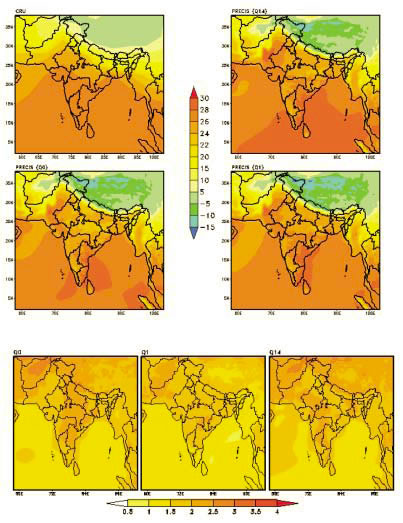
(Source: Ministry of Environment and Forests, 40)
7. Type of Habitat
Rajasthan- Arid
Mumbai- Coastal
Below is a Google Earth Picture of a Rural Village in Rajasthan (left) and the city of Mumbai (right)

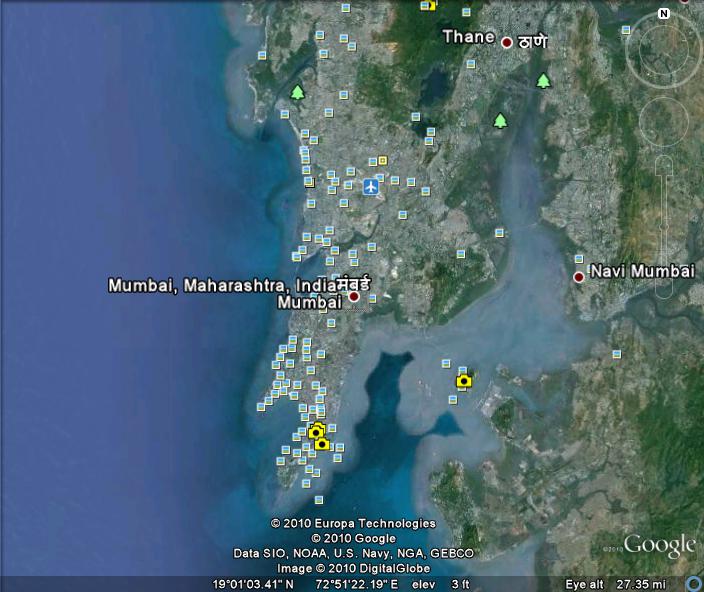
8. Act and Harm Sites:
There would be environmental degradation in Mumbai because of the large population and demand the economic demands of India. The population is growing at a rate of 1.376%. In 2009, the real growth rate of Gross Domestic Product was 7.4%. Composition of the Indian economy by sector was recorded as agriculture at 17.1%, industry at 28.2%, and services at 54.6%. (CIA World Factbook) Rajasthan’s rural areas will continue to become more arid. (Jodha, 4)

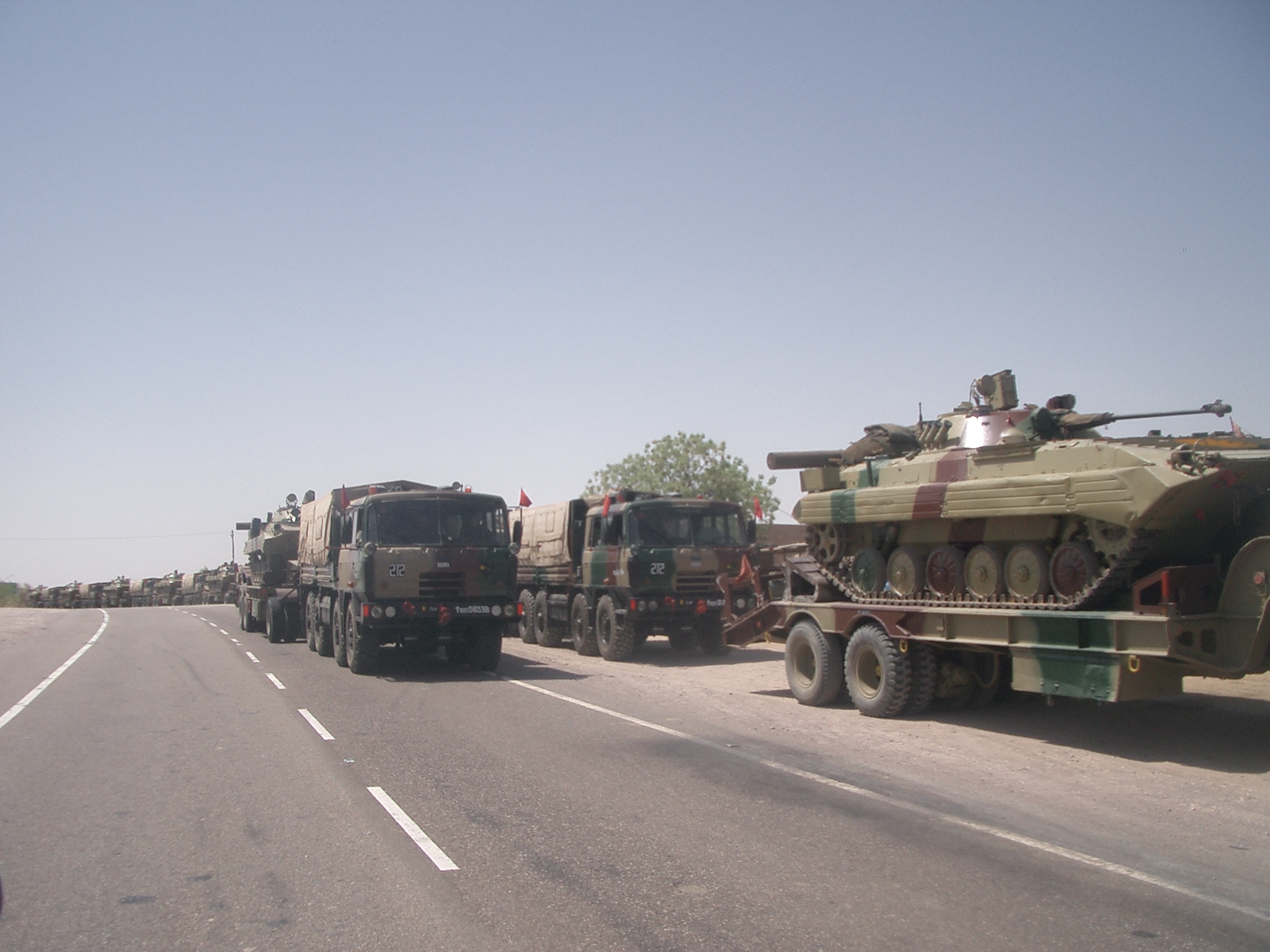
9. Type of Conflict: Non-state and Intra-state
The type of conflict will be civilian fueled by religious dislike and competition for resources. The Indian military will become involved in the conflict if the conflict continues for a long time and worsens. The conflict is civil, but this type of conflict could be found in the other areas of the world with similar circumstances. This conflict is unique to India, but similar resource and religious conflicts could occur in areas with scarce resources and religious tension.
10. Level of Conflict: Medium
The conflict revolves around two things: the competition for resources and the existing religious tensions. With the influx of people into this urban area naturally there will be more economic competition, thus causing conflict or social tension between groups of people. The direct cause of the conflict is the increase of people in an urban area and therefore the increased demand of resources. These resources could become scarce due to Climate Change and the increased population from the migration would accelerate the lack of resources.
11. Fatality Level of Dispute (military and civilian fatalities)
The following are statistics of past and present conflicts that are similar to this case’s future dispute.
- Name and Year: NDFB(National Democratic Front for Bodoland) 1989-90; 1993-2004
- Type of Conflict: Bengali migration caused ethnic conflict and conflict over territory
- Fatalities: 2, 310
- Name and Year: Sikh Insurgents 1983-1993
- Type of Conflict: Sikh insurgents from Northern India demanded autonomy from India, but they were defeated by the military in 1993. The war occurred from 1991-1993.
- Fatalities: 10,019 (1991-93)
(Source: World Bank Dataset on Violence)

12. Environment-Conflict Link and Dynamics:
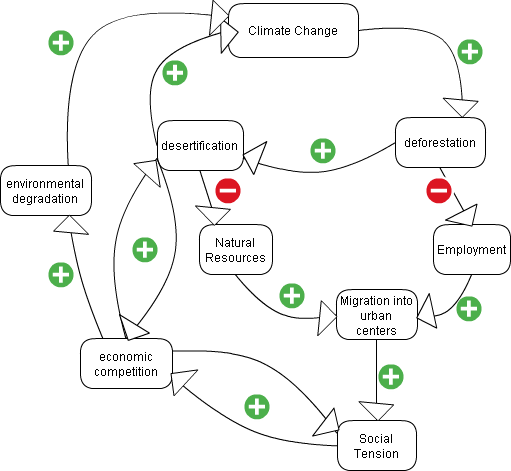
This causal diagram begins with Climate Change as the cause for the following variables. The first variable in the diagram is deforestation because this tends to be the main cause of migration. As climate change begins to affect an area, villagers look for new sources of income. The diagram expresses that as deforestation increases desertification increases; desertification is caused by the lack of forest in the area. Since, there is desertification in the area, this leads to more arid land and climate change in the area. So, this is a small causal loop within the larger diagram and it explains the reason for migration into the urban areas. There could be intervening variables in this loop because there could be a reason why the villagers decided to cut down the forest in the first place. For instance, climate change could have already been occurring in the area and therefore there were not enough resources to live off of. This would force the villagers to sell their forest to a big business. This is the case for a few different villages in Rajasthan.
The variable deforestation has an arrow going to employment because as the resources from the area leave there will be less employment opportunities. Big business is in the urban centers and when the resources go to these centers the people must follow them for employment. Employment refers to the way in which these villagers can make an appropriate income for their family. Many of these villagers were able to live off of the land and use the resources of the land, but through climate change and deforestation there are very little resources available in these desert areas. The arrow goes from desertification to natural resources because with the desertification of an area there will be less resources. The term natural resources refer to trees/vegetation, water sources, and high levels of animals. The lack of both employment and natural resources in these areas increase the amount of migration into urban centers. Migration of these villagers can create social tension in these urban centers. These social tensions are caused by religious differences, inequities in the caste system and general lack of space in these areas.
With the increased social tensions economic competition increases because there are more people in these urban centers and more animosity to be the best in the area. The need to assert dominance in an area is the driving factor in this economic competition. This need was created by the social tension from the migration of these villagers into the city area. Economic competition is linked to desertification because with the competition to be the best in the area there is a need to obtain resources. The more a business grows the more demand they have for a product. For instance, a paper company needs a specific type of tree to make a thick paper for businesses in the city. The more these businesses grow the more of this tree the paper company will have to cut down to supply the demand from these growing businesses. Economic competition means cutting corners for many businesses and this means pollution or environmental degradation of the cities and areas around the city. Environmental degradation can include anything from run-off into the water supply from chemical plants that manufacture these goods to the energy used everyday to power the building that the employees of a company work in. The environmental degradation in these cities continues to perpetuate climate change. This is diagram is very much like a race to the bottom theory because it is a cycle of environmental degradation.
13. Level of Strategic Interest: Region
I-1. Mounting Demographic Pressures
I-2. Massive Movement of Refugees or Internally Displaced Persons creating
Complex Humanitarian Emergencies
I-3. Legacy of Vengeance-Seeking Group Grievance or Group Paranoia
I-4. Chronic and Sustained Human Flight
Economic Indicators
I-5. Uneven Economic Development along Group Lines
I-6. Sharp and/or Severe Economic Decline
Political Indicators
I-7. Criminalization and/or Delegitimization of the State
I-8. Progressive Deterioration of Public Services
I-9. Suspension or Arbitrary Application of the Rule of Law and Widespread
Violation of Human Rights
I-10. Security Apparatus Operates as a "State Within a State"
I-11. Rise of Factionalized Elites
I-12. Intervention of Other States or External Political Actors
(Source: The Fund for Peace)
14. Outcome of Dispute: In-Progress

15. Related ICE Cases
No.22 - Elsalv
No.94 - Vineland
No.11 - Kaliman
16. Relevant Websites and Literature
1. Agrawal, Arun, and Clark C. Gibson. "Enchantment and Disenchantment: The Role of Community in Natural Resource Conservation." IDEAS: Economics and Finance Research. Apr. 1999. Web. 25 Sept. 2010. <http://ideas.repec.org/a/eee/wdevel/v27y1999i4p629-649.html>.
2. "CIA - The World Factbook." Welcome to the CIA Web Site — Central Intelligence Agency. Web. 13 Dec. 2010. <https://www.cia.gov/library/publications/the-world-factbook/>.
3. Deshingkar, Priya. "Internal Migration, Poverty and Development in Asia: Including the Excluded." IDS Bulletin 37.3 (2006): 88-100. Wiley Online Library. March 2006. Web. 4 Nov. 2010. < http://www.odi.org.uk/resources/download/4633-full-paper.pdf >.
4. "Dharavi Slum." BBC News - Home. Web. 13 Dec. 2010. <http://news.bbc.co.uk/2/shared/spl/hi/world/06/dharavi_slum/html/dharavi_slum_intro.stm>.
5. "Failed States and the Fund for Peace’s Failed States Index 2010 « Clouds, Clocks and Sitting at Tables." Clouds, Clocks and Sitting at Tables. Web. 13 Dec. 2010. <http://jdasovic.com/2010/09/22/failed-states-and-the-fund-for-peaces-failed-states-index-2010/>.
6. "Hindu-Muslim Conflict and the Partition of India." HyperHistory.net. Web. 13 Dec. 2010. <http://www.hyperhistory.net/apwh/essays/cot/t3w30pakistanindia.htm>.
7. "India." World Bank Group. Web. 13 Dec. 2010. <http://web.worldbank.org/WBSITE/EXTERNAL/TOPICS/EXTSOCIALDEVELOPMENT/EXTCPR/0,,contentMDK:22488819~menuPK:6835249~pagePK:148956~piPK:216618~theSitePK:407740,00.html >.
8. Jacoby, Hanan, Mariano Rabassa, and Emmanuel Skoufias. On The Distributional Implications of Climate Change: A Methodological Framework and Application to Rural India. The World Bank, Aug. 2009. Web. 1 Oct. 2010. <http://nip-lac.org/uploads/Emmanuel_SkoufiasBA.pdf>.
9. Jodha, N. S. "Population Growth and the Decline of Common Property Resources in Rajasthan, India." JSTOR. Population and Development Review, June 1985. Web. 10 Nov. 2010. <http://www.jstor.org/pss/1973488>.
10. Kershner, Isabel. "Deadly Violence Erupts Again in India's Hindu-Muslim Conflict - New York Times." The New York Times - Breaking News, World News & Multimedia. Web. 13 Dec. 2010. <http://www.nytimes.com/2002/05/09/world/deadly-violence-erupts-again-in-india-s-hindu-muslim-conflict.html>.
11. Kundu, Amitabh, and Shalini Gupta. "Migration, Urbanisation and Regional Inequality." Economic and Political Weekly 31.52 (1996): 3391+. JSTOR. Web. 27 Nov. 2010. <http://www.jstor.org/stable/4404940>.
12. Kundu, Amitabh. "Migration, Urbanisation and Inter-Regional Inequality: The Emerging Socio-Political Challenge." JSTOR. JSTOR, 15 Nov. 1986. Web. 30 Sept. 2010. <http://www.jstor.org/pss/4376331>.
13. Ministry of Environment and Forests. Climate Change and India: A 4x4 Assessment. Rep. Government of India, Nov. 2010. Web. 13 Dec. 2010. <http://moef.nic.in/downloads/public-information/fin-rpt-incca.pdf>.
14. "Religion & Ethics NewsWeekly . COVER STORY . Hindu-Muslim Conflict in India . May 24, 2002 | PBS." PBS: Public Broadcasting Service. Web. 13 Dec. 2010. <http://www.pbs.org/wnet/religionandethics/week538/cover.html>.
15. Ribbons, Paul. "The Rotten Institution: Corruption in Natural Resource Management." Political Geography 19.4 (2000): 423-43. ScienceDirect. May 2000. Web. 1 Nov. 2010. <http://www.sciencedirect.com/>.
16. Robbins, Paul. "Nomadization in Rajasthan, India: Migration, Institutions, and Economy." Human Ecology 26.1 (1998): 87-112. SpringerLink. Web. 26 Nov. 2010. <http://www.springerlink.com/content/v2552v4141417433/>.
17. Scoones, Ian. Sustainable Rural Livelihoods: A Framework for Analysis. Institute of Development Studies, 1998. IDS Working Paper 72. PDF.
18. "The History of Hindu-Muslim Conflict | EHow.com." EHow | How To Do Just About Everything! | How To Videos & Articles. Web. 13 Dec. 2010. <http://www.ehow.com/about_5479428_history-hindumuslim-conflict.html>.
19. Williamson, Jeffrey G. "Regional Inequality and the Process of National Development: A Description of the Patterns." JSTOR. Economic Development and Cultural Change, July 1965. Web. 17 Nov. 2010. <http://www.jstor.org/pss/1152097>.
20. Yadav, R.K., K. Rupa Kumar, and M. Rajeevan. "Climate Change Scenarios for Northwest India Winter Season." Quaternary International 213.1-2 (2010): 12-19. ScienceDirect. Web. 1 Dec. 2010. http://www.sciencedirect.com

[Fall 2010, Lauren Carroll©]
